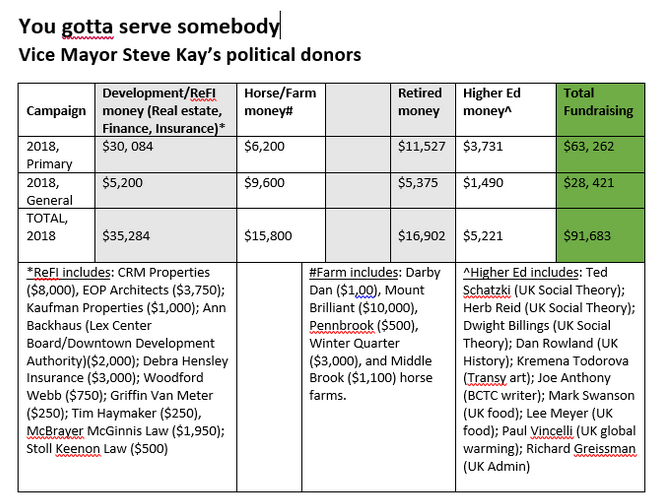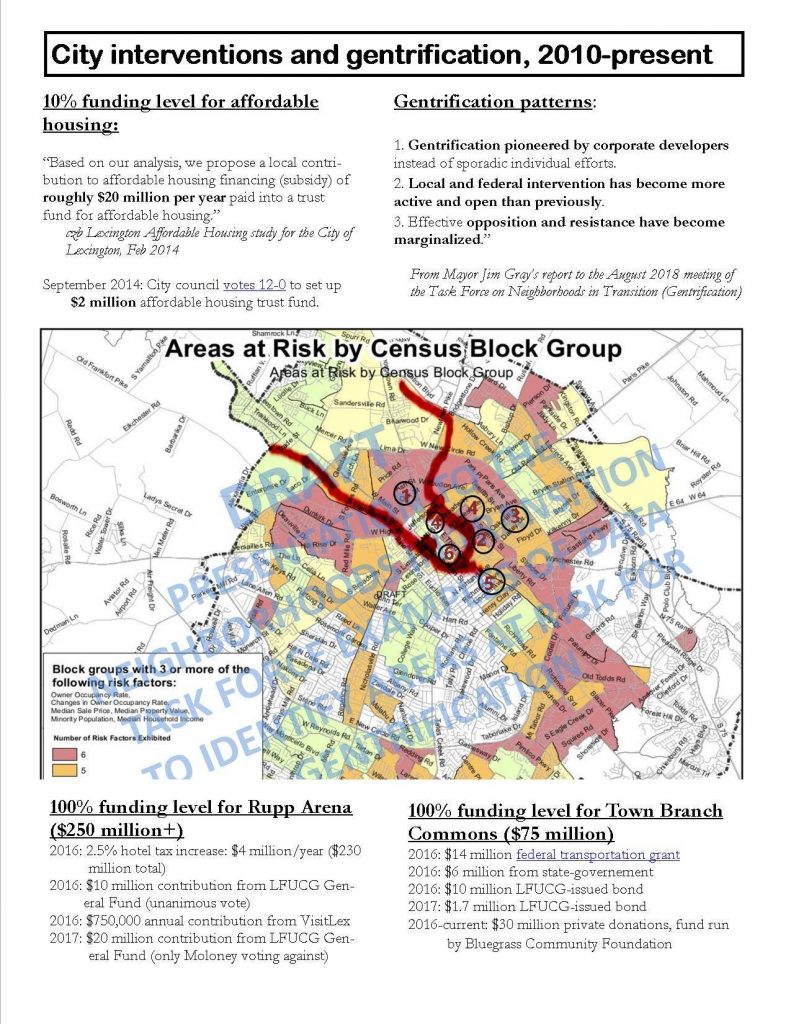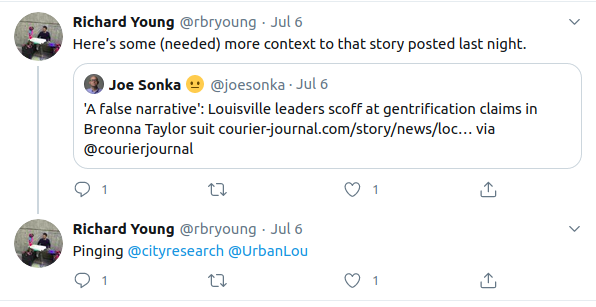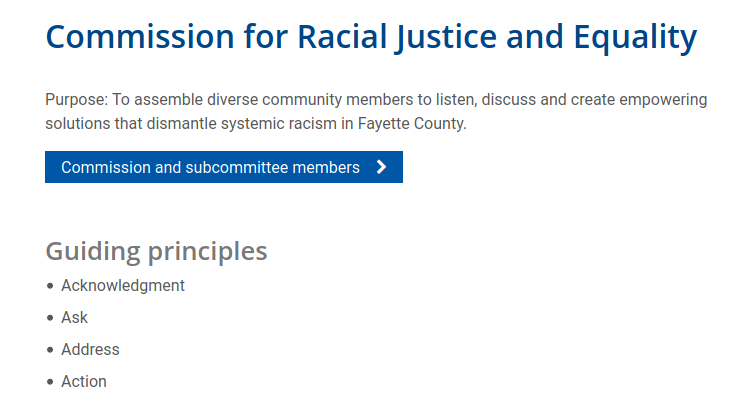Today, the Lexington sub-committee on Housing and Gentrification will conduct its second public meeting. This sub-committee is one of five such committees organized under the Commission of Racial Justice and Accountability, created by Mayor Linda Gorton in the wake of the George Floyd protests in order to address systemic racism within the city. The work of these groups is organized under mandates to acknowledge, ask, address, and take action on the root causes of systemic Lexington racism.
Below are some story-lines to help get readers up to speed on the Housing and Gentrification subcommittee. In the spirit of the Commission, these story lines are organized under the guiding principals of acknowledging, asking, addressing, and taking action. You can watch the sub-committee on Housing and Gentrification here. The committee meets on Thursdays at 6:30 pm.
Acknowledge: the shoddy NiT(G) legacy
Though nominally a brand new working group, the 11-member housing and gentrification subcommittee in fact grows out of the ongoing work of the much larger Mayor’s Task Force on Neighborhoods in Transition (NiT), which began meeting to much fanfare in July 2018. Despite the acclaim , however, the Task Force has been dogged by shoddy and disorganized work. This owes most directly to its focus on an invented term, transitioning neighborhoods, to stand in place of what the rest of the world, outside of our Task Force, understands as gentrification.
It’s not hard to see why the NiT(G) Task Force was so resistant to naming the gentrification process. Put together by District 1 Council Member James Brown and Vice Mayor Steve Kay, both of whom rely on political donations from area developers and gentrifying business owners, the 27-person Task Force was packed with those citizens who benefited from gentrification.

Kris Nonn of the North Limestone (NoLi) Community Development, which took affordable housing funds to provide artist housing for gentrifying northsiders and has long been targeted by area residents as a key agent of gentrification, was represented. Nonn’s voice was amplified by the inclusion of NoLi CDC board member Shayla Lynch. Slumlords Jeff Moore (over 100 properties appraised below $50,000) and Robert Hodge (50 mostly East End properties valued under $50,000) were also represented by the Task Force.

Those pro-developer links were augmented by the inclusion of a variety of pro-business public servants. Fayette County Property Valuation Administrator David O’Neill, who remained silent during the run-up in housing prices in gentrifying areas over the previous decade, got a seat at the table. So, too, did Derek Paulson, the Planning Commissioner for pro-gentrification Mayor Jim Gray, get a seat. As did Stan Harvey, a Steve Kay donor and lead organizer of the city’s push to renovate Rupp Arena. Ditto Ed Holmes, a Steve Kay and James Brown political donor. (Adding a further layer of insider activity, Holmes, Harvey, and Nonn also served with Kay on the city’s powerful Infill and Redevelopment committee.)
Balancing out these development foxes in the NiT(G) henhouse were a grab-bag of generally pliant non-profit heads who led agencies dependent on city funding (Lexington Fair Housing Council, Lexington Community LandTrust, Lexington Human Rights Commission, Lexington Habitat for Humanity, Lexington Urban League).
Notably, the Task Force included exactly one non-connected member of the community–the substitute teacher and East End resident Denise Brown.
Given NiT(G)’s member composition, it should come as no surprise that its main goals seemed to be distraction and delay. How else to understand how a Task Force that was created to look at the problem of poor people being displaced from upscaling neighborhoods could decide to wait over 15 meetings (a year-and-a-half!) to inquire into the city’s affordable housing trust fund. Or why the only person to discuss gentrification at any length was an undergraduate University of Kentucky student who was interning for the Mayor. Or why, after two years, the Task Force refused to do a single case study of a gentrifying (woops….transitioning) city neighborhood. Or why its main goals involved getting displaced residents to identify with their gentrifying landlords–and for them to bone up on the city’s 300+ page Master Plan–rather than looking into what actions city leaders took that may have enabled displacement.

What residents ultimately got from this long-running Task Force was a bunch of disconnected data, much of which was produced in the first four months of meetings and then recycled in ways that wasted everyone’s time for the next 20 months. As a civic exercise, it was akin to members of a global warming task force restricting their inquiry solely to Lexington daily temperature records of the past half-decade—and then taking a half-decade to deliver a report.
As we are finding out now, it did matter that our city’s leading lights chose to produce shoddy and mostly useless work. Now that the George Floyd protests have forced cities to reckon with unequal development, our fair city has been left flatfooted, still clueless about what’s been happening over the past decade in its own backyard.
With respect to the work of the current gentrification committee, it will be interesting to see if they acknowledge the NiT(G)’s poor work—and also why that work was made to be so pathetically bad.
Ask: the Schein factor
You may not know Rich Schein, a dean at the University of Kentucky who was formerly on faculty in the Geography Department, but you are most likely becoming aware of his work. If a person talks about race and development in this city–from the work here at North of Center to the Take Back Cheapside group that successfully got the city to remove two Confederate Statues—they are drawing from Schein’s thirty years of scholarship and teaching on race and landscape in downtown Lexington.

Though he was not on the NiT(G) Task Force, Schein was asked to be on the current Housing and Gentrification subcommittee. If that group’s first meeting is any indication, the UK geographer will be the go-to committee member, a person looked to for both scholarship and direction. Where will Schein lead?
There are some indications that he will lead the group into the sort of inquiry that was sorely absent from the NiT(G). Unlike the data-oriented minds that shutdown the NiT(G), Schein is a qualitative geographer, one more focused on processes and case studies than decontextualized numbers. And though it is less known than his racial work that looks at Lexington, Schein’s pre-University of Kentucky work also looked at how a university city, Syracuse, New York, altered its economic development strategies to encourage a creative class entreprenurialism that non-Lexington scholars have for some time fingered as a key driver of gentrification and systemic community racism.

In other words, Schein studied in Syracuse the economic model that Lexington has been implementing with its budget funds and development priorities for over a decade. Since gentrification is not specifically about race but also class and capital, this should be a good counterweight for the subcommittee to (finally) address.
Of course, it is not a slam dunk that Schein will help the gentrification subcommitte produce anything worthwhile. For one, Schein’s Lexington work ends at about 2005. In other words, his work on racial landscapes in Lexington ends at about the moment gentrification picks up here. As well-suited as he may become, at the moment he is another in a long line of non-expert experts utilized by our city leaders when forced to address gentrification.
Second, as a UK professor–even one who has done such great work—there is a question of how much Schein will push back in order to keep his high-placed university standing. There is precedence for this, and it comes from Schein’s home department, UK Geography.
For the past two years, Associate Professor Matt Wilson, a cartographer housed in the Geography department, has played the role of colonialist mapmaker for the NiT(G) Task Force via his work overseeing the UK Mapshop. In what must come as a surprise to most cartographers, Wilson told the NiT(G) that data on public subsidies was not able to be collected and could not be mapped. Thus, political choices to subsidize projects like the $250 million Rupp Arena renovation, or the $300 million investment in the World Equestrian Games, or $32 million spent to upscale the city’s old courthouse into a tourist hub…were dismissed via Wilson as irrelevant to understanding how booming near-urban neighborhoods pushed low-income people away. These nearly billion dollars in local leverage dedicated to upscale urban developers were left out of the NiT(G)’s data sets on poor removal from adjacent urban neighborhoods.

So, Schein is by no means a slam dunk as a game-changing committee member. He is good at drawing out hard points as a UK professor. But the question remains, what sorts of questions will he push the current gentrification committee to ask? Which questions will he let slide?
Address: Housing and Gentrification composition
As you watch the Housing and Gentrification committee deliberate on your computer screen, take note of a few things that should give you pause. The first is that, in what is doubtless a case of failing up, nearly half, or 5 of the 11 committee members, are drawn from that failed NiT(G) group that whiffed on examining Lexington’s gentrification problems. (Gerald Smith, who oversees all five of the subcommittee groups, was also a member of NiT(G).)
This heavy NiT(G) composition includes Housing and Gentrification co-chairs Shayla Lynch (board member for the gentrifying nonprofit NoLi CDC) and Ray Sexton. It also includes NiT(G) convener and councilmember James Brown (the man who arrived at the NiT(G) Task Force armed with…a 2 sentence dictionary definition of gentrification). Ditto for Habitat for Humanity’s Rachel Childress. The slumlord Robert Hodge also made the cut—though the substitute teacher Denise Brown did not.

But the committee is also notable for how it does not conform to the other subcommittees: unlike the others, this committee looking at who owns and controls the land is majority white. And to the degree that people of color sit on the committee, these people do not represent everyday engaged citizens but rather empowered actors—muckety mucks and, in the case of Hodge, an East End slumlord whose real estate is about to be upgraded from a $10 million TIF investment the city awarded to two white developers (one a former Vice Mayor) for a Third Street “revitalization” project.
Given the fact that land ownership and control has played a central role in any discussion of systemic racism–going all the way back to Reconstruction debates over 40 acres and a mule–and also that the previous NiT(G) Task Force was such a public failure, the choice to pack the new committee with recycled non-expert committee members who contributed to the earlier failure, and to keep the group mostly white, was a curious choice indeed—assuming the city is honest in its attempts to engage with systemic racism in the area of housing and gentrification.
Look to see if the committee spends any time addressing their curious composition, or if this gets colored over.
Act: the Louisville case
Two weeks ago, lawyers for the family of Breonna Taylor, the Louisville woman shot by police in her bed, sued the city. The grounds for their lawsuit hinge in part on showing that the city made formal plans to gentrify Taylor’s Russel neighborhood, located a short distance from the downtown core, and that these plans led to her death.
Thus far, Louisville officials have defined the claim as a “gross mischaracterization” of its plans for the area, and some Lexington non-profit heads have (unsurprisingly) supported that position.

But while the lawsuit will likely hinge on whether lawmakers can prove a direct connection between the police’s actions and the city’s redevelopment plans for the area, it has already served to puncture the positive assumptions utilized by elected and other leaders across the western world to characterize pro-development strategies that have mostly benefited wealthy citizens at the expense of disempowering already-marginalized ones.
The Taylor gentrification lawsuit calls into question buzzwords like ‘revitalization’, the do-gooder actions of neighborhood nonprofit groups that perform the city’s work on the ground, and the immense giveaways reflexively delivered to a new generation of developers under the pretext of economic sanity.
In other words, the Louisville lawsuit highlights the very thing the previous Task Force, the NiT(G), sought to dismiss outright: it requires that those who care about Taylor’s death analyze her neighborhood in depth, and that those who care consider how their elected leadership and business leaders, in broad daylight and championed by local media, made choices that, for a lot of people, were the very opposite of ‘revitalization’.
As the current sub-committee on Housing and Gentrification kicks into gear, take note of whether its members act on the issues of city management, governance, and leadership that the Taylor-Gentrification lawsuit so publicly raises.





Yong Guan
It’s odd but not surprising to see so many from the subset of Legends In Their Own Aging Minds from the set of the Well-Off Pretend Left from the University of Kentucky (Schatzki, Reid, Billings, Rowland, Meyer) cuddled up in bed with CRM Properties, Lex. Center Corporation, Terry McBrayer, and select members of the horsey set
Billie C Mallory
It seems to me from observing this committee that it may be more aggressive in pursuing facts (if they don’t get bogged down in the weeds with Code Enforcement). They are at least willing to use the word gentrification, which by any other name, such as transition, is still ‘decline by neglect’ and sometimes intent by the government. I was surprised that CM Brown actually attributed some blame to the city for allowing some neighborhoods to fall into ruin. I hear some tough questions being asked, mainly by the ministers with a conscience for social justice, so we will see how far that will go. Also to their tribute, they actually want to hear from people that have been so negatively impacted. They have already seemed to surpass the TF on being honest and willing to listen and explore some of the tougher issues with an open mind. I hope that this group remains intact, unlike most of the members of the TF walking away from lack of productivity. But no matter what this group does or recommends, it is essential that the Mayor and Council actually do something and take the actions needed–which remains to be seen.